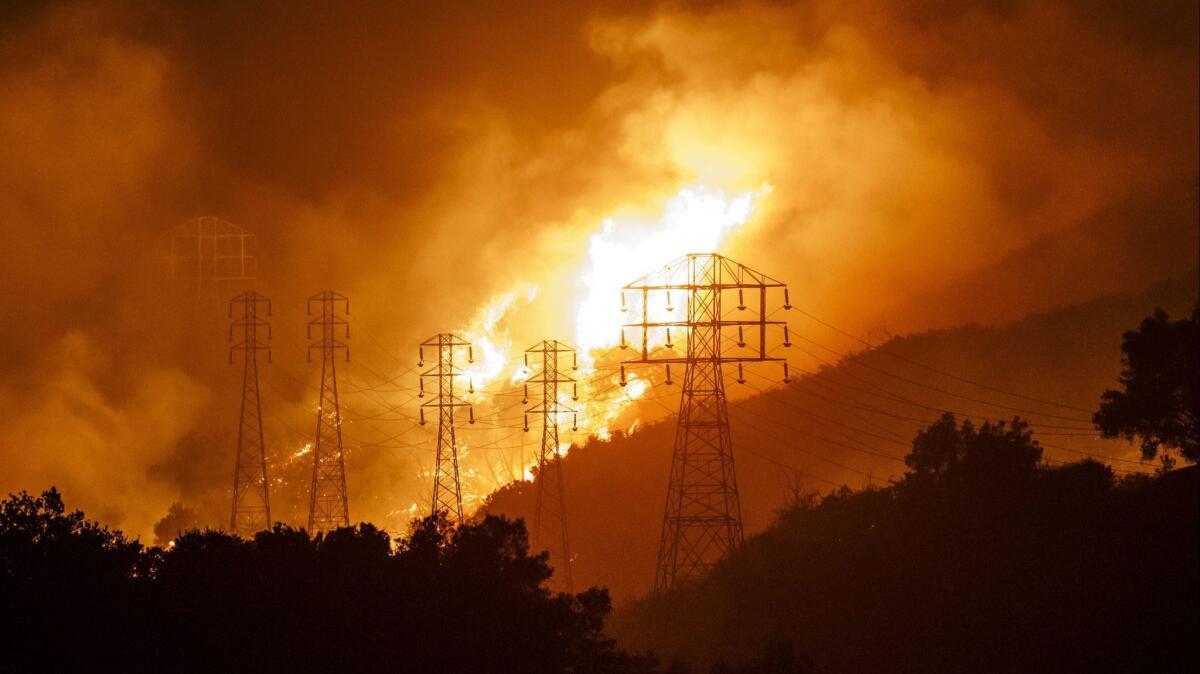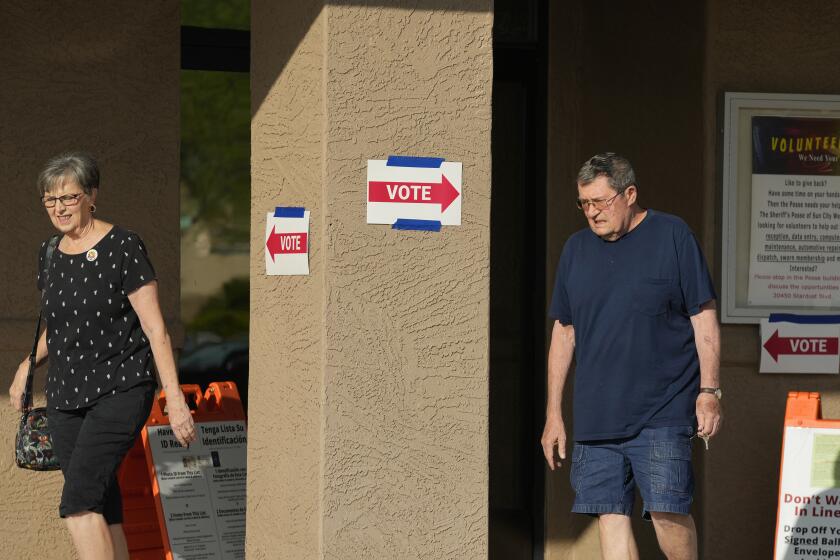Newsom asks California lawmakers to lead the way in deciding who pays wildfire costs

Gov. Gavin Newsom urged lawmakers on Friday to rethink existing rules on how California utilities pay for wildfires sparked by their equipment, but stopped short of embracing any specific solution to the political impasse over the amount of help the companies need to remain solvent.
“Everybody has to participate,” he said of who must pay the costs of fire response and recovery. “All of us have to row in the same direction.”
The governor traveled to the state’s emergency services center to unveil the final report of a “strike team” he convened in February to craft a comprehensive wildfire strategy for California’s energy sector. The effort was prompted by Pacific Gas & Electric’s decision to file for bankruptcy protection in January after its top executives said the company could not pay the estimated $30 billion in damages from its role in deadly Northern California wildfires in 2017 and 2018.
The 52-page report recommends changes in state fire prevention and response, including updating some local building codes to include rules on defensible space and additional work to identify sufficient evacuation routes. It vows to hold PG&E financially accountable to fire victims and communities and urges a focus on clean energy production, suggesting government officials should consider a state-run program to buy electricity from sources that don’t accelerate climate change and the conditions that have worsened California’s fire dangers.
But Newsom’s task force did not offer a specific recommendation on how to shoulder the significant financial impact of utility-sparked wildfires such as those that have ravaged California over the past decade. Instead, it proposed extending discussions with various stakeholders for an additional two months in hopes of reaching consensus on a new model for paying fire-related costs.
Nor would the governor offer any sense of what path forward he sees as most viable.
“I’m purposely not including my personal opinions because I actually want to accomplish something,” he said Friday. “And I believe it’s incumbent upon me to create the conditions where we can actually get something done, versus to assert a political frame.”
Under state law, the current system to determine liability is based on the legal principle known as inverse condemnation, which holds a utility strictly liable whenever its equipment ignites a fire — regardless of whether the company is found to be negligent. That structure is guaranteed by a provision of the California Constitution; changing it would require voter approval or — if the governor’s advisors are correct — rare action by the California Supreme Court.
The report released Friday outlines key issues of helping victims and ensuring reliable electrical service that should be considered when revamping the process but concludes that a politically viable solution will take more time. It recommends that a state wildfire panel created last year bring forward a proposal later this summer.
And the governor said that hinges on the Legislature finding consensus — not him championing any particular approach. Newsom urged lawmakers to take action before they take their summer recess in mid-July.
“We have 90 days,” Newsom said. “I’m hopeful that they can meet this moment.”
A discussion of how to structure future wildfire liability for California’s three investor-owned utilities — PG&E, Southern California Edison and San Diego Gas & Electric — has dominated debate in the state Capitol for more than a year. The utilities insist that the existing doctrine is too punitive, particularly given the new normal of a long wildfire season.
The Next California: Natural disaster can define a California governor’s legacy »
In 2018, then-Gov. Jerry Brown urged the Legislature to limit the instances in which a utility is forced to pay the full amount of fire costs. Brown’s proposal would have given California judges the flexibility to weigh the public benefit of a utility’s services against the fire damage to private property.
But the termed-out governor found no takers. Legislative hearings on the topic were raw with emotion, as wildfire victims and local officials insisted such a change was tantamount to a utility bailout. They worried that the companies would drag out legal proceedings, leaving communities devastated by deadly blazes without the money needed to rebuild.
They accused the utilities of failing to adequately prepare for wildfire conditions — relying on outdated and dangerous equipment, including dilapidated wooden power poles, and letting fire-prone vegetation grow too close to power lines over wide swaths of rugged California terrain.
The final agreement last summer left the rules of inverse condemnation in place but offered utilities new methods to finance fire-related expenses by imposing a special surcharge on ratepayers that could be used for long-term borrowing. That option requires the California Public Utilities Commission to first perform a financial “stress test” of the utility to see whether new customer payments are needed. Early efforts to expand that process — allowing it to be used to pay costs for last year’s deadly fires — remain a political nonstarter in Sacramento.
“We have a lot of work to do,” said state Sen. Bill Dodd (D-Napa), an architect of last year’s agreement. Dodd said the governor’s approach to focus on the most immediate threat — likely to be junk-bond status and possible insolvency of one or more investor-owned utilities — makes sense.
“What we’re trying to do first is provide that backstop, that protection for the utilities that the credit rating agencies are looking for,” he said.
The Newsom report agrees that new liability rules could link utility fire costs to a determination of the company’s fault: “Where the utility acted negligently, recklessly, or with intentional misconduct, it would still be responsible for paying damages, including possible punitive damages.”
But the change could have a profound effect on property owners and insurance companies. Costs from a fire in which a utility was not found to be at fault would have to be paid by an insurance policy or the property owners themselves. The insurance industry has a powerful lobby in Sacramento, one likely to argue that fewer homeowner policies would be written for those who live in high-risk regions. On Friday, insurance industry groups were silent on liability changes, choosing instead to applaud the report’s mention of a possible new pooled insurance fund for those with no other alternatives.
Two other options outlined by the Newsom task force focus on special cash reserve funds for covering wildfire costs, a concept floated by legislators last year. One proposal would create a fund to serve as “bridge financing” for a utility to pay wildfire claims while CPUC regulators consider a long-term plan. The other envisions a utility-funded program to absorb some of the costs. It would also limit an insurance company’s ability to defray its own fire-related payments by seeking reimbursement from the utility.
The report also addresses less-controversial topics. It reaffirms the governor’s commitment to remove fire-prone vegetation and calls for beefing up the wildfire prevention responsibilities of utility regulators. CPUC officials would be able to conduct new inspections and investigations of utility efforts. Other recommendations include additional laws to “clarify” when the agency can allow fire costs to be passed along to utility customers.
While the governor declined to embrace any specific path forward on paying wildfire costs, his administration hinted earlier in the week that it’s no longer feasible to place the entire burden on utility companies.
A memo from a former CPUC administrative law judge warned of large electricity rate hikes without new government action.
“If wildfires persist at the levels we have experienced recently, and all customers of the major electric utilities had to bear the burden, average rates throughout California would have to increase by 50% in the first year, alone,” Steven Weissman, now a UC Berkeley law professor, wrote to a top Newsom aide.
He also warned that higher electricity costs could force some high-tech companies to leave the state.
“If California cannot offer reliable and affordable power, we risk losing our innovation economy to other states,” he wrote.
Follow @johnmyers on Twitter and sign up for our daily Essential Politics newsletter
More to Read
Get the L.A. Times Politics newsletter
Deeply reported insights into legislation, politics and policy from Sacramento, Washington and beyond. In your inbox three times per week.
You may occasionally receive promotional content from the Los Angeles Times.











